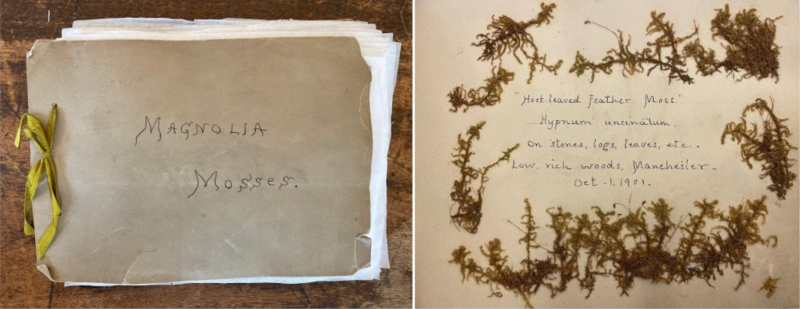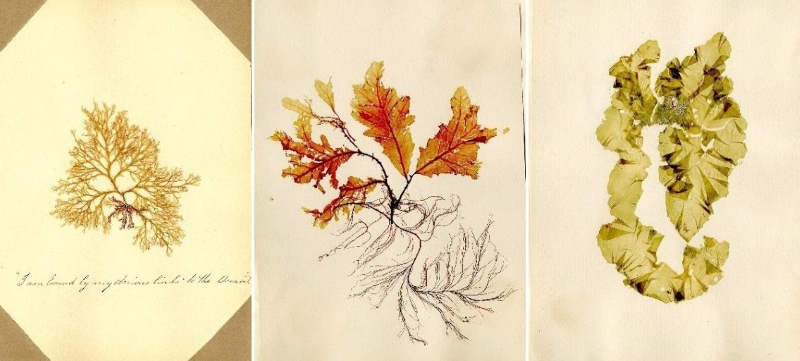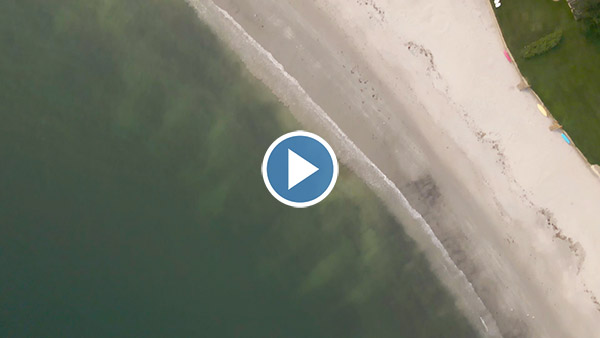August 5, 2021
August 5, 2021

George Wainwright Harvey (1855-1930), The Two Cousins: Eliza and Maude, 1884, watercolor on paper. Collection of the Cape Ann Museum, Gloucester, MA. Gift of the Estate of Dorothy Buhler, 1985 [Acc. #2466.50].

Dear Friends,
It has been such a pleasure seeing and welcoming you back to the Museum in recent weeks!
Your attendance in CAM's galleries, at exhibition openings, and through continued virtual and in-person programming is paramount to our mission and we remain so grateful for your enthusiasm and support. With many new opportunities this summer at CAM to engage and convene around art and ideas, I greatly look forward to welcoming you to both Museum campuses in the weeks ahead.
Moreover, for those interested in obtaining a unique view of just some of the beaches mentioned in this CAM Connects issue, please consider joining the Museum on one of our Sunset Sails with the Schooner Thomas E. Lannon. Click here for more information and to make a reservation.

Oliver Barker, Director
Beaches
With the landscape of Cape Ann defined by granite and water, it is no surprise that the borderline between them—the beach—is a special place for many of us. Whether you're a local or visitor, are swimming, fishing, or painting, the place where the water meets the land is held in high regard by us all. In this issue of CAM Connects, we look at the swimwear, sand, stone, mosses, and of course the art that is inspired by beaches. ■
Aerial Views of Cape Ann Beaches
Video still of aerial view above Singing Beach. Taken from a drone operated by Jameson Burke.
For a different perspective on the lush natural beauty of the beaches of Cape Ann, we commissioned drone pilot (and friend of the Museum) Jameson Burke to give us a bird’s-eye view of some of the area’s favorite swimming spots. The footage, captured from hundreds of feet in the air, provides a rarely seen perspective of the surf, stones, and sand that surrounds the great knuckle of granite that is Cape Ann. Featured beaches include Singing Beach, Magnolia Beach, Pavilion Beach, Front Beach, and Lighthouse Beach. ■
Upcoming exhibition, Learning to Swim

[Left] Elaine Wing, Niles Beach, 1995, oil on canvas. Collection of the Cape Ann Museum, Gloucester, MA. Gift of Robert L. and Elizabeth French, 2009 [Acc. #2009.51.19]. [Middle] Joy Halsted, Cold Water #1, 2010, acrylic on canvas. Collection of the Cape Ann Museum, Gloucester, MA. Gift of the artist, 2016 [Acc. #2016.051.1]. [Right] Doris Prouty, Lane’s Cove. 2017. Applique quilt. Lent by the Prouty Family.
Opening in just over a week on August 14 in the Janet & William Ellery James Center at the CAM Green, the exhibition Learning to Swim pairs an interactive map made by the Cape Ann Museum's Teen Arts Council where locals can share their memories of learning to swim with artwork and archival photographs from the Museum’s collection that depict these popular swimming spots. Paintings by Joy Halsted, Elaine Wing, Norma Cuneo, Jessica Tam, Bernard Chaet, Jeff Weaver, and Dorothy Arnold look at the water through the lens of an artist while photographs from our archives capture the joy of swimming through the ages.
This summer, the Cape Ann Museum introduced its first ever Teen Arts Council, a program that aims to help teens develop leadership skills while creating youth-focused events and initiatives that will draw more young people to the Museum. The council’s first five members live in area towns and hope to help the Museum develop an inclusive space which will allow local teenagers to get involved and enjoy what the Museum has to offer.
The Teen Arts Council plans to launch a regular “Teen Arts Night” series starting with an outdoor event on Friday, Aug. 20 at the CAM Green for local teens to hang out, make art and view the exhibition.
And be sure to sign up for two upcoming programs related to the exhibit:
Swimming to the Top of the Tide with Patricia Hanlon – August 21st
Learning to Figure Draw workshop – September 4th & 11th
A highlight in the upcoming Learning to Swim exhibition, the above quilt (right) by Doris Elizabeth Prouty showing Lane's Cove is best appreciated in person.
Lane’s Cove is one of the smallest harbors in the region. It was created in the 1830s by men from Quincy, MA, who were opening up the earliest commercial quarries on Cape Ann. Made of cut granite blocks, the site was first used to load stone onto sailing vessels which transported it up and down the coast. The Cove was also used by shore fishermen who kept their gear in shacks clustered around the shoreline. The City of Gloucester acquired the Cove in the 1960s, making it public property and a premier place to learn to swim.

Lane’s Cove, c. 1964. Photograph by Barbara Erkkila. Collection of the Cape Ann Museum Library & Archives, Gloucester, MA. Gift of Barbara Erkkila, 2014 [Acc. #2014.028].
Doris Prouty was a resident of Lanesville and an accomplished quilt maker. In the words of her family, Doris “created quilts in Lanesville for over forty years, and was a self-trained, non-academic female artist working in the African American folk and gift traditions.” The Museum shares the family’s belief that Doris’ work belongs within the story of the artists of Cape Ann. ■
Bathing Suits and the Evolution of Swimming
By Petra Slinkard
Director of Curatorial Affairs / Nancy B. Putnam Curator of Fashion and Textiles, Peabody Essex Museum
At the turn of the 20th century, the nation became fascinated and fixated on living a healthier and more active lifestyle. Thousands of people sought beaches out on either coast as a form of relaxation and entertainment.

Pavilion Beach, 1910. Benham Collection of the Cape Ann Museum Library & Archives, Gloucester, MA. [Acc. #1994.52.3]
For many, and women in particular, a day at the beach was relegated to the sand and dipping your toes in the water. It was considered taboo for women to swim in the late 19th and early 20th centuries. Even the sinking of the General Slocum on June 15, 1904 (the second worst maritime disaster on U.S. waterways) did not immediately clue people into the importance of swimming. An estimated 1,021 people (mostly women and girls) of the 1,342 on board died. Public figures like Annette Kellerman, a professional athlete and vaudeville star, actively campaigned for women’s right to swim, and slowly society began to embrace the exercise as a lifesaving skill and one that keeps the body trim.
However, the fight was not over. As bathing costumes evolved to show more skin, female beachgoers were subjected to “beach police.” Women had to contend not only with itchy wool bathing dresses but also with men who invaded their personal space in order to measure the length of their hems.

Addison Gilbert Hospital Nurses at Good Harbor Beach (Marjorie Morton Marble, Norma Wise Greel, and Shirley Slate Greenwood), 1947. Eleanor V. Spiller Collection of the Cape Ann Museum Library & Archives, Gloucester, MA.
Nevertheless, by the 1940s and 1950s styles began to evolve into functional, fashionable sportswear designed for active, stylish women. When the risqué bikini made its public debut at a fashion show in Paris in 1946, it prompted women to rethink the design of functional and fashionable swimwear and reclaim the presentation of their bodies. By the 1970s, the bikini was a staple at beaches and pools the world over. ■
To view two examples of 20th century beachwear, visit the Peabody Essex Museum’s Fashion and Design gallery (3rd floor of the new wing).

[Standing] Bathing dress, about 1900, by artist in the United States, Wool. Gift of Mrs. W. Ogilvie Comstock, 1965; 131160.AB; [Seated] Dipster bikini, late 1970s, by E. I. du Pont de Nemours and Company, Wilmington, Delaware, Founded 1802, Tyvek™. Gift of Elizabeth Lahikainen, 2000; 138150.AB. On view now in the Fashion and Design Gallery (3rd floor of new wing); Peabody Essex Museum, Salem, MA
Ballast Beaches

Horse Drawn Ballast Cart, 1890s. Photograph by Martha Hale Harvey. Collection of the Cape Ann Museum Library & Archives, Gloucester, MA.
Not all of Cape Ann’s beaches are ideal for swimming. Ironically, some of the region’s rockiest beaches, like Pebble Beach in Rockport, have historically proven useful precisely because of the rocks that make them so unappealing to beach-goers. Back in the 19th century, when the local fleet was still fishing under sail, beach stones served as the cheapest and most readily available kind of ballast. The stones would have been carefully laid in a ship’s hold and provided a stabilizing weight that prevented the ships from tipping over under the force of the wind. A schooner of 60 tons could carry up to 20 to 30 tons of ballast stones (that’s up to half its weight) in order to sail and fish safely in storms and heavy seas.
Stones were typically collected by local contractors who would haul them by horse drawn cart to vessels waiting at the wharves. The sizes of ballast stones varied from golf-ball to football size. When placed in the vessel, the different sizes allowed the spaces between larger stones to be filled with smaller ones, while still leaving air spaces for drainage and ventilation. Smooth-worn beach stones, like those found at Pebble Beach, were preferred for ballast because they were easier to keep clean. Fishing vessels kept the same ballast stones for years, hiring workers, called scrubbers, to remove and clean them when the fish holds were being cleaned. ■
Preserving Sea Moss Specimens: A Victorian Era Pastime at Cape Ann's Beaches

Cover and page from handmade paper book, tied with green ribbon, Magnolia Mosses, undated. Archival Collection 93: Sea Moss and Seaweed Collection of the Cape Ann Museum Library & Archives, Gloucester, MA.
In the mid-19th century when the work of Charles Darwin helped to spark interest in the natural world, Victorian ladies regularly engaged in the practice of gathering sea moss and algae from the seashore and pressing the specimens into artistic arrangements. The Cape Ann Museum Archives holds a collection of these preserved sea mosses that were assembled primarily at Cape Ann area beaches from around 1848 to about 1905 by several local individuals.

Cover and pages of hardcover, fold out book, Sea Mosses: Prepared and arranged by Miss Maria Bray. Exhibited as the World Fair at Chicago, undated. Archival Collection 93: Sea Moss and Seaweed Collection of the Cape Ann Museum Library & Archives, Gloucester, MA.
Included in bound volumes and on loose cards, the designs in CAM’s collection are quite varied, with colors ranging from pale olive to golden brown to deep burgundy. Some of the plant forms resemble ferns or vines while others are more delicate and feathery in nature. One volume entitled Sea Mosses: Prepared and Arranged by Miss Maria Bray, Exhibited at the World Fair in Chicago indicates the high regard in which these collections were held by the public.

Miscellaneous pressed sea moss on pages from Archival Collection 93: Sea Moss and Seaweed Collection of the Cape Ann Museum Library & Archives, Gloucester, MA.
Read more about CAM’s collection of sea mosses on the Museum website, browse through the Archival Collection’s Finding Aid, and make an appointment to come in and view them in person by emailing library@capeannmuseum.org. ■
CAM Library & Archives – New Acquisition
While the “CAM Virtual” team was in the midst of putting together this issue of CAM Connects, the Library & Archives was contacted by previous Gloucester resident Philip Hayden with a generous, and very timely, donation offer. Philip was the son of Edwin Parker Hayden, Jr., the first editor of the newspaper Cape Ann Summer Sun, and according to both Philip and a 1985 Boston Sunday Globe article, he has been a “sandcastle enthusiast since he was 8.” That enthusiasm quickly turned into a passion combined with talent and skill for making elaborate and award-winning sandcastles.

[Left] Philip Hayden nearing completion on a sandcastle, complete with moat. Photograph by the Gloucester Daily Times, 1982. [Right] Completed sandcastle on Raymond’s Beach, 1981. Photograph by Edwin Parker Hayden, Jr. Collection of the Cape Ann Museum Library & Archives. Gift of Philip Hayden, 2021 [Acc. #2021.041].
Seen above are just a couple photographs of Philip’s stunning sandcastles from the donated collection which includes hundreds of photographs, sketches, newspaper articles, and even some of the awards that he won. Hayden made sandcastles along the East Coast, but locally he could be found at Crane Beach and most frequently at Raymond’s Beach on Eastern Point. The incredible collection is currently being inventoried and processed, and portions of photographs will soon be digitized.

1979 Designs: Traditional designs of castles & Gregorian house designs. Sketches made by Philip Hayden in advance of building a sandcastle. Collection of the Cape Ann Museum Library & Archives, Gloucester, MA. Gift of Philip Hayden, 2021 [Acc. #2021.041].
Make an appointment to view the collection and other beach related material in the CAM Library & Archives by emailing library@capeannmuseum.org. ■
Unsubscribe | Forward | View in browser
CAPE ANN MUSEUM
27 Pleasant Street, Gloucester, MA 01930
CAPE ANN MUSEUM GREEN
13 Poplar Street, Gloucester, MA 01930
Cape Ann is one of the most important places in the history of American art and industry.
The Cape Ann Museum, thanks to supporters like you, celebrates the history and remarkable contributions of this place to the cultural enhancement of our community and the world at large - yesterday, today and tomorro

